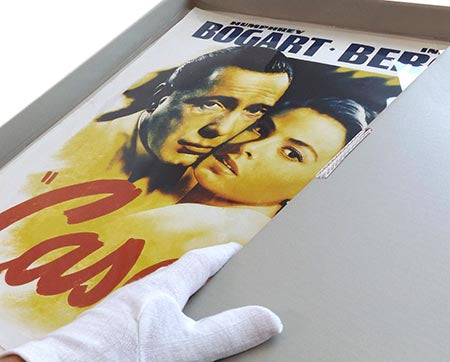
Preserve & Care for Your Vintage Posters
Share
How to Preserve and Care for Your Vintage Poster Collection
1. Understanding the Composition of Vintage Posters
Before diving into preservation techniques, it’s important to understand the materials that make up vintage posters. Most vintage posters were printed on:
- Paper: Often thin and prone to tearing or yellowing with age.
- Inks: These can fade or smudge if exposed to light, moisture, or improper handling.
2. Handling Your Posters Properly
Improper handling can cause irreversible damage to vintage posters. Follow these best practices:
- Clean Hands: Always wash your hands and ensure they are dry before handling posters. Oils and dirt from your skin can stain the paper.
- Use Gloves: Cotton or nitrile gloves provide an extra layer of protection against smudges and moisture.
- Avoid Bending or Rolling: Always handle posters flat or support them with a rigid backing to prevent creasing.
- When unRolling a poster, be gentle and take your time to avoid introducing new creases or tears.
Cleaning a vintage poster requires great care to avoid causing further damage. Follow these guidelines:
- Dusting: Use a soft, lint-free cloth or a clean artist’s brush to remove dust. Avoid pressing too hard.
- Stain Removal: For stubborn stains, consult a professional conservator. Attempting to remove stains with water or chemicals can lead to irreversible damage.
- Never use adhesives, tape, or other materials to patch up torn areas without professional guidance.
Exposure to light, particularly ultraviolet (UV) rays, is one of the most significant threats to vintage posters. To protect them:
- Avoid Direct Sunlight: Display posters away from windows or areas with intense sunlight.
- Use UV-Protective Glass: If framing your poster, opt for UV-filtering glass or acrylic to block harmful rays.
- Control Indoor Lighting: Use LED lights, which emit less UV radiation, and position light sources at a safe distance.
5. Framing Your Posters
Proper framing not only enhances the visual appeal of your posters but also provides essential protection. Key considerations include:
- Acid-Free Materials: Use acid-free mat boards and backing to prevent paper degradation.
- Reversible Mounting: Avoid adhesives or permanent mounting methods. Hinges made from archival tape allow the poster to be removed without damage.
- Sealed Frames: Ensure the frame is sealed to prevent dust, moisture, and pests from entering.
6. Storing Your Posters Safely
If you’re not displaying your posters, proper storage is essential to prevent damage. Here’s how:
- Flat Storage: Store posters flat in acid-free folders or archival boxes to minimize the risk of creasing.
- Rolled Storage: For larger posters, roll them around an acid-free tube and cover with protective paper. Avoid rolling too tightly.
- Climate Control: Keep storage areas cool, dry, and free from humidity. Ideal conditions are around 68°F (20°C) with 40-50% relative humidity.
7. Protecting Against Pests and Mold
Pests and mold can wreak havoc on vintage posters. Preventative measures include:
- Sealed Storage: Use archival-quality boxes or sleeves to keep out pests.
- Silica Gel Packs: Place silica gel packs in storage containers to control humidity.
- Regular Inspections: Check your posters periodically for signs of pests or mold. Address issues promptly if detected.
If your vintage poster is damaged, restoration can help preserve it. However, restoration should only be performed by professionals. Restoration techniques include:
- Tear Repairs: Using Japanese tissue and archival adhesives to mend tears.
- Deacidification: Neutralizing acids in the paper to prevent further deterioration.
- Linen Backing: Attaching the poster to a linen backing for added stability and protection.
9. Documenting Your Collection
Maintaining a record of your collection is an essential part of poster preservation. Include the following details:
- Photographs: Take high-resolution images of each poster for reference.
- Condition Reports: Note any existing damage or areas of concern.
- Provenance and Purchase Records: Keep records of where and when each poster was acquired.
10. Insurance and Appraisals
To protect the value of your vintage poster collection, consider:
- Appraisals: Have your collection appraised by a qualified expert to determine its current market value.
- Insurance Coverage: Obtain a policy that covers art and collectibles, ensuring protection against theft, fire, and other risks.
- Updated Records: Reassess the value of your collection periodically and update your insurance coverage as needed.
While physical preservation is crucial, creating digital backups of your collection adds another layer of security. Use high-quality scanning equipment or hire professionals to digitize your posters. Digital files serve multiple purposes:
- Cataloging: Maintain an organized digital inventory.
- Sharing: Share your collection with other enthusiasts without risking physical damage.
- Archival Backup: Ensure a digital copy exists in case of physical loss or damage.
Preserving vintage posters is a continuous learning process. Engage with resources and communities to stay informed:
- Books and Guides: Reference authoritative books on poster conservation and care.
- Online Forums: Join communities of poster enthusiasts and conservators to exchange tips and advice.
- Workshops: Attend workshops or webinars on art preservation techniques.
- Learning from experts and peers can enhance your preservation efforts.
Conclusion
Preserving your vintage poster collection requires time, effort, and attention to detail, but the rewards are worth it. By following the guidelines in this article, you can ensure that your posters remain vibrant and valuable for years to come. Whether you’re a seasoned collector or just starting out, proper care and preservation techniques will help you protect these timeless treasures.
Relevant Links to Publicly Available Images
Example of Framed Vintage Posters (Public Domain)
Poster Restoration Techniques (Public Domain)
UV Protective Glass Display (Public Domain)
Archival Storage Materials (Public Domain)
Digitizing Vintage Posters (Public Domain)
These images illustrate various preservation techniques and tools discussed in the article.
Note on Featured Image - https://www.preservationequipment.com/Blog/Blog-Posts/The-complete-guide-on-how-to-preserve-and-store-a-movie-poster




